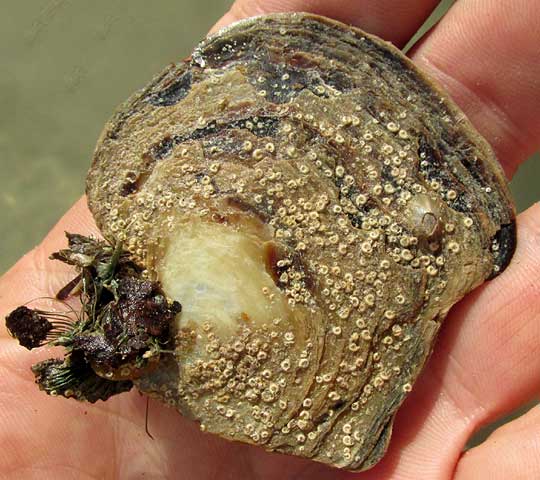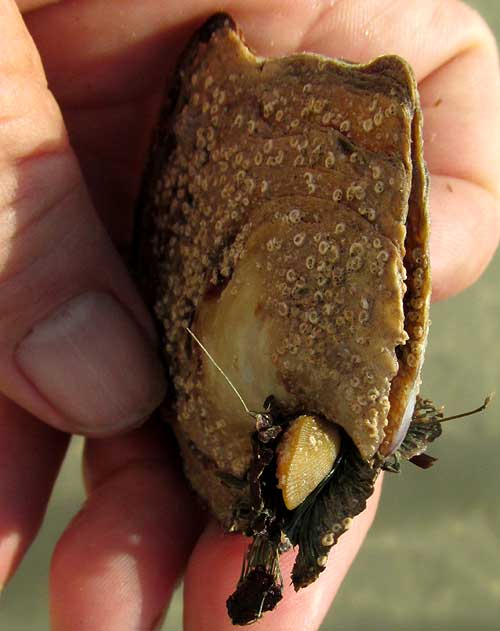Excerpts from Jim Conrad's
Naturalist Newsletter
from the March 8, 2015 Newsletter issued from Río Lagartos, on the Yucatan Peninsula's northern coast (~N21.60°, ~W88.16°), Yucatán state, MÉXICO
FLAT TREE OYSTERS
At low tide we were on the mudflats across the estuary from Río Lagartos developing a new tour concept, "Low Tide Tours." We were looking around to see what there was to show tourists later. At the edge of the mudflat Jorge waded into a dense, shadowy tangle of Red Mangrove stilt-roots and soon called me over. He pointed into a dark, dank part of the tangle where I could see nothing special, even when my eyes adjusted to the darkness. The thing Jorge was showing was so well camouflaged that he had to tap it with a stick. Below, you can see where he pointed:

That picture shows alga-covered Red Mangrove roots barely above the water, with what Jorge was trying to show me occupying the lower, left third of the image. It's a collection of vertically positioned, flattish, brownish oysters clinging to roots. Once you knew what to look for, there must have been thousands of them, hundreds of thousands in that general area, a major presence I'd never realized was there.
These are Flat Tree Oysters, ISOGNOMON ALATUS, found throughout the Caribbean and Gulf of Mexico from southern Florida to Brazil. Its main habitat is the roots of Red Mangroves but also it occurs in shallow, rocky areas down to depths of 50 feet (15m).
Flat Tree Oysters are filter feeders who draw water into their shell and pass it through gills, extracting plankton and small organic particles for food. The mollusks reach about 3½ inches (9cm) in length and attach themselves to roots and rocks by a "byssus thread." A byssus is a group of strong filaments secreted by some families of bivalve molluscs, for attaching themselves to hard surfaces. In the past, a fine fabric called "byssus cloth" was made from the byssuses of pen shells.
Jorge, wanting to add some to the aquarium back at the restaurant/tour office, pulled some oysters from their roots. Below, you can see one, its shell covered with tiny Spirorbis Worm Tubes (polychaetes in curled, snail-like tubes) and a barnacle, with pieces of mangrove bark sticking to its byssus threads:

A frontal view showing its flatness, with a small bivalve incongruously wedged among its byssus threads, is shown below:

Flat Tree Oyster shells are pearly and lustrous inside but the species isn't known for producing pearls. Locally folks sometimes eat them, though you don't see the oyster being collected for food the way you do with conchs on the mudflats.